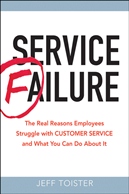Three Customers You Shouldn't Serve, Part 2
 Jeff Toister
Jeff Toister  Tuesday, September 29, 2009 at 8:55PM |
Tuesday, September 29, 2009 at 8:55PM |  This post is the second in a three part series on customers you shouldn't serve.
This post is the second in a three part series on customers you shouldn't serve.
Last week, I shared three types of customers you should avoid. This week, I have a few suggestions on how to work with these customers should you inevitably encounter one. (Do nothing at your own risk -- these customers all have the potential to hurt your business!)
1. They want what you can't deliver well
Customers often ask us to provide products or services that are outside our "sweet spot". It may be tempting to try our best to give them what they want, but this can be a recipe for future failure. Instead, consider a few alternatives:
- Re-frame the customer's request to see if you have something you can offer that will meet their needs.
- Refer your customer to someone who can do the job and do it well.
- Provide your customer with resources that will allow them to find a solution.
2. You can't serve them profitably
Unless you are running a charity, you need to make a profit to stay in business. Here are a few suggestions to make customers more profitable:
- Fix problems. If your service is poor or you've subjected your customer to problems, you should fix those first. Getting it right the first time is almost always cheaper in the long run.
- Hold late-payers accountable. Customers that habitually pay late (or cause other damages) should held accountable through late fees or a discontinuation of service until their account is current.
- Renegotiate. Consider renegotiating your price or terms of service if your margins are too thin.
3. They are abusive
Politely, but firmly let your customer know that abuse will not be tolerated. The revenue you receive from an abusive customer is rarely worth the stress it causes employees and the high cost of servicing these customers.




